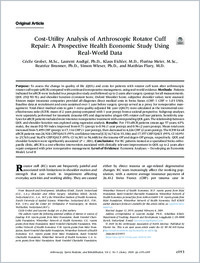Cost-Utility Analysis of Arthroscopic Rotator Cuff Repair: A Prospective Health Economic Study Using Real-World Data.
- Grobet C Research and Development, Schulthess Klinik, Zurich, Switzerland.
- Audigé L Research and Development, Schulthess Klinik, Zurich, Switzerland.
- Eichler K Winterthur Institute of Health Economics, Zurich University of Applied Sciences, Winterthur, Switzerland.
- Meier F Winterthur Institute of Health Economics, Zurich University of Applied Sciences, Winterthur, Switzerland.
- Brunner B Winterthur Institute of Health Economics, Zurich University of Applied Sciences, Winterthur, Switzerland.
- Wieser S Winterthur Institute of Health Economics, Zurich University of Applied Sciences, Winterthur, Switzerland.
- Flury M Shoulder and Elbow Surgery, Schulthess Klinik, Zurich, Switzerland.
- 2020-06-18
Published in:
- Arthroscopy, sports medicine, and rehabilitation. - 2020
English
Purpose
To assess the change in quality of life (QOL) and costs for patients with rotator cuff tears after arthroscopic rotator cuff repair (aRCR) compared with continued nonoperative management, using real-world evidence.
Methods
Patients indicated for aRCR were included in a prospective study and followed up to 2 years after surgery (postop) for all measurements. QOL (EQ-5D-5L) and shoulder function (Constant Score, Oxford Shoulder Score, subjective shoulder value) were assessed. Sixteen major insurance companies provided all-diagnoses direct medical costs in Swiss francs (CHF; 1 CHF = 1.03 USD). Baseline data at recruitment and costs sustained over 1 year before surgery (preop) served as a proxy for nonoperative management. Total direct medical costs to gain 1 extra quality-adjusted life year (QALY) were calculated as the incremental cost-effectiveness ratio (ICER; mean of 2 years postop compared with 1 year preop) from a societal perspective. Subgroup analyses were separately performed for traumatic (trauma-OP) and degenerative (degen-OP) rotator cuff tear patients. Sensitivity analyses for aRCR patients included more intensive nonoperative treatment with corresponding QOL gain. The relationship between QOL and shoulder function was explored using regression analysis.
Results
For 153 aRCR patients (mean age 57 years; 63% male), the mean EQ-5D index improved from 0.71 (preop) to 0.94 (1 year postop) and 0.96 (2 years postop). Mean total costs increased from 5,499 CHF (preop) to 17,116 CHF (1 year postop), then decreased to 4,226 CHF (2 years postop). The ICER for all aRCR patients was 24,924 CHF/QALY (95% confidence interval [CI] 16,742 to 33,106) and 17,357 CHF/QALY (95% CI 10,951 to 23,763) and 36,474 CHF/QALY (95% CI 16,301 to 56,648) for the trauma-OP and degen-OP groups, respectively. QOL and shoulder function were significantly associated (P < .001).
Conclusions
For RC patients treated at a specialized Swiss orthopaedic clinic, aRCR is a cost-effective intervention associated with clinically relevant improvement in QOL up to 2 years after repair compared with prior nonoperative management.
Level of Evidence
Economic Analyses - Developing an Economic Model, Level II.
To assess the change in quality of life (QOL) and costs for patients with rotator cuff tears after arthroscopic rotator cuff repair (aRCR) compared with continued nonoperative management, using real-world evidence.
Methods
Patients indicated for aRCR were included in a prospective study and followed up to 2 years after surgery (postop) for all measurements. QOL (EQ-5D-5L) and shoulder function (Constant Score, Oxford Shoulder Score, subjective shoulder value) were assessed. Sixteen major insurance companies provided all-diagnoses direct medical costs in Swiss francs (CHF; 1 CHF = 1.03 USD). Baseline data at recruitment and costs sustained over 1 year before surgery (preop) served as a proxy for nonoperative management. Total direct medical costs to gain 1 extra quality-adjusted life year (QALY) were calculated as the incremental cost-effectiveness ratio (ICER; mean of 2 years postop compared with 1 year preop) from a societal perspective. Subgroup analyses were separately performed for traumatic (trauma-OP) and degenerative (degen-OP) rotator cuff tear patients. Sensitivity analyses for aRCR patients included more intensive nonoperative treatment with corresponding QOL gain. The relationship between QOL and shoulder function was explored using regression analysis.
Results
For 153 aRCR patients (mean age 57 years; 63% male), the mean EQ-5D index improved from 0.71 (preop) to 0.94 (1 year postop) and 0.96 (2 years postop). Mean total costs increased from 5,499 CHF (preop) to 17,116 CHF (1 year postop), then decreased to 4,226 CHF (2 years postop). The ICER for all aRCR patients was 24,924 CHF/QALY (95% confidence interval [CI] 16,742 to 33,106) and 17,357 CHF/QALY (95% CI 10,951 to 23,763) and 36,474 CHF/QALY (95% CI 16,301 to 56,648) for the trauma-OP and degen-OP groups, respectively. QOL and shoulder function were significantly associated (P < .001).
Conclusions
For RC patients treated at a specialized Swiss orthopaedic clinic, aRCR is a cost-effective intervention associated with clinically relevant improvement in QOL up to 2 years after repair compared with prior nonoperative management.
Level of Evidence
Economic Analyses - Developing an Economic Model, Level II.
- Language
-
- English
- Open access status
- gold
- Identifiers
-
- DOI 10.1016/j.asmr.2020.02.001
- PMID 32548584
- Persistent URL
- https://folia.unifr.ch/global/documents/279195
Statistics
Document views: 11
File downloads:
- fulltext.pdf: 0
